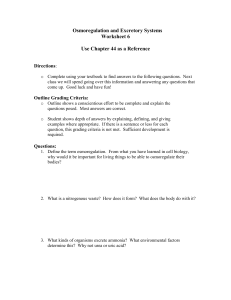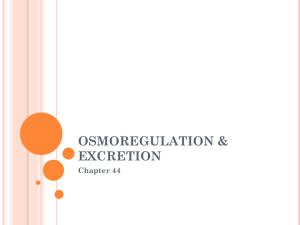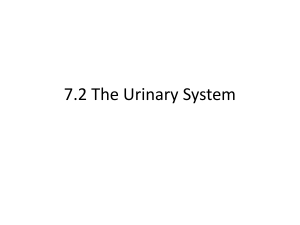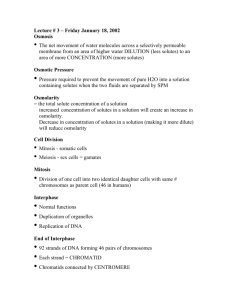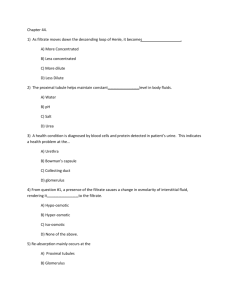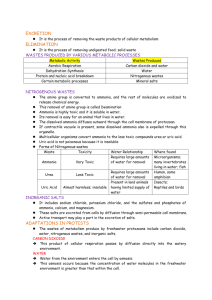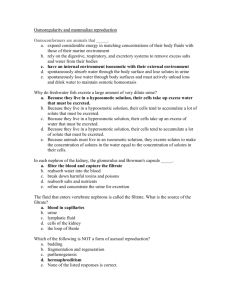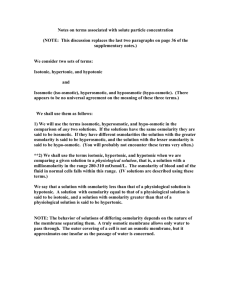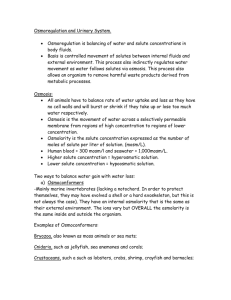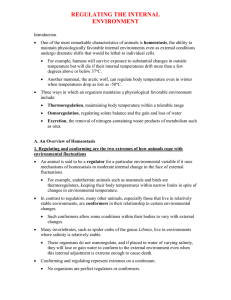Ch 44 Osmoregulation & Excretion Osmoregulation regulates solute
advertisement
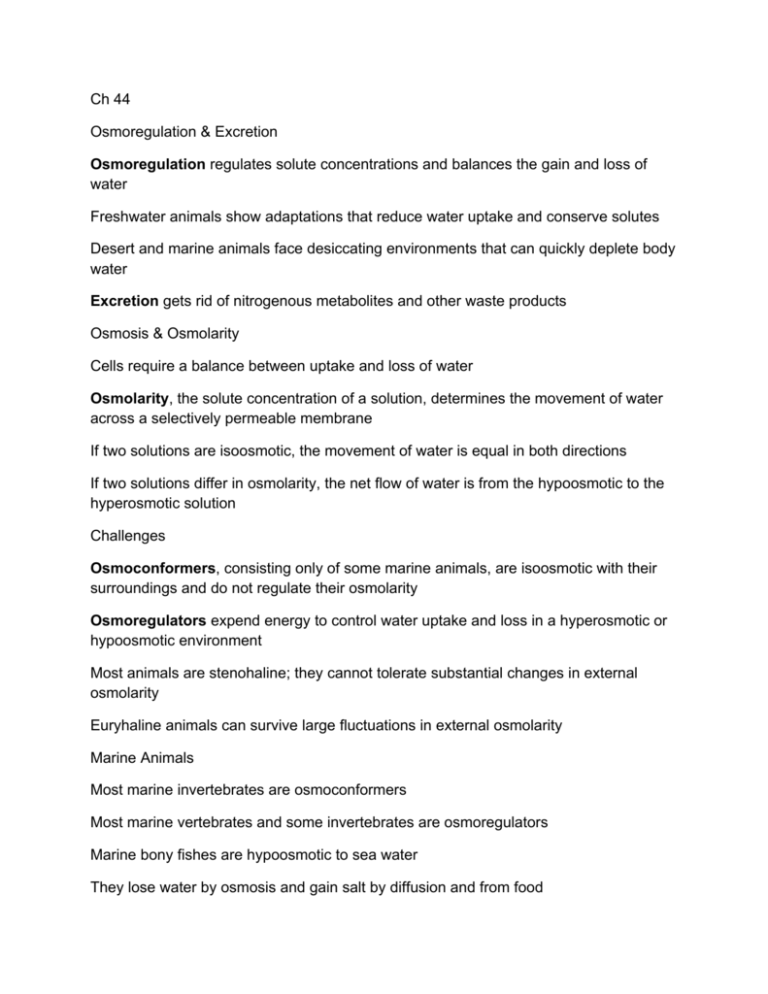
Ch 44 Osmoregulation & Excretion Osmoregulation regulates solute concentrations and balances the gain and loss of water Freshwater animals show adaptations that reduce water uptake and conserve solutes Desert and marine animals face desiccating environments that can quickly deplete body water Excretion gets rid of nitrogenous metabolites and other waste products Osmosis & Osmolarity Cells require a balance between uptake and loss of water Osmolarity, the solute concentration of a solution, determines the movement of water across a selectively permeable membrane If two solutions are isoosmotic, the movement of water is equal in both directions If two solutions differ in osmolarity, the net flow of water is from the hypoosmotic to the hyperosmotic solution Challenges Osmoconformers, consisting only of some marine animals, are isoosmotic with their surroundings and do not regulate their osmolarity Osmoregulators expend energy to control water uptake and loss in a hyperosmotic or hypoosmotic environment Most animals are stenohaline; they cannot tolerate substantial changes in external osmolarity Euryhaline animals can survive large fluctuations in external osmolarity Marine Animals Most marine invertebrates are osmoconformers Most marine vertebrates and some invertebrates are osmoregulators Marine bony fishes are hypoosmotic to sea water They lose water by osmosis and gain salt by diffusion and from food They balance water loss by drinking seawater and excreting salts Freshwater Animals Freshwater animals constantly take in water by osmosis from their hypoosmotic environment They lose salts by diffusion and maintain water balance by excreting large amounts of dilute urine Salts lost by diffusion are replaced in foods and by uptake across the gills Some aquatic invertebrates in temporary ponds lose almost all their body water and survive in a dormant state This adaptation is called anhydrobiosis Land Animals Adaptations to reduce water loss are key to survival on land Body coverings of most terrestrial animals help prevent dehydration Desert animals get major water savings from simple anatomical features and behaviors such as a nocturnal life style Land animals maintain water balance by eating moist food and producing water metabolically through cellular respiration Energetics Osmoregulators must expend energy to maintain osmotic gradients The amount of energy differs based on How different the animal’s osmolarity is from its surroundings How easily water and solutes move across the animal’s surface The work required to pump solutes across the membrane Transport epithelia Animals regulate the solute content of body fluid that bathes their cells Transport epithelia are epithelial cells that are specialized for moving solutes in specific directions They are typically arranged in complex tubular networks An example is in nasal glands of marine birds, which remove excess sodium chloride from the blood Nitrogenous wastes The type and quantity of an animal’s waste products may greatly affect its water balance Among the most significant wastes are nitrogenous breakdown products of proteins and nucleic acids Some animals convert toxic ammonia (NH3) to less toxic compounds prior to excretion Animals excrete nitrogenous wastes in different forms: ammonia, urea, or uric acid These differ in toxicity and the energy costs of producing them Ammonia Animals that excrete nitrogenous wastes as ammonia need access to lots of water They release ammonia across the whole body surface or through gills Urea The liver of mammals and most adult amphibians converts ammonia to the less toxic urea The circulatory system carries urea to the kidneys, where it is excreted Conversion of ammonia to urea is energetically expensive; excretion of urea requires less water than ammonia Uric Acid Insects, land snails, and many reptiles, including birds, mainly excrete uric acid Uric acid is relatively nontoxic and does not dissolve readily in water It can be secreted as a paste with little water loss Uric acid is more energetically expensive to produce than urea The kinds of nitrogenous wastes excreted depend on an animal’s evolutionary history and habitat, especially water availability Another factor is the immediate environment of the animal egg The amount of nitrogenous waste is coupled to the animal’s energy budget Excretory Processes Most excretory systems produce urine by refining a filtrate derived from body fluids Key functions of most excretory systems Filtration: Filtering of body fluids Reabsorption: Reclaiming valuable solutes Secretion: Adding nonessential solutes and wastes from the body fluids to the filtrate Excretion: Processed filtrate containing nitrogenous wastes, released from the body A protonephridium is a network of dead-end tubules connected to external openings The smallest branches of the network are capped by a cellular unit called a flame bulb These tubules excrete a dilute fluid and function in osmoregulation Each segment of an earthworm has a pair of open-ended metanephridia Metanephridia consist of tubules that collect coelomic fluid and produce dilute urine for excretion Malpighian tubules In insects and other terrestrial arthropods, Malpighian tubules remove nitrogenous wastes from hemolymph and function in osmoregulation Insects produce a relatively dry waste matter, mainly uric acid, an important adaptation to terrestrial life Some terrestrial insects can also take up water from the air Kidneys Kidneys, the excretory organs of vertebrates, function in both excretion and osmoregulation The filtrate produced in Bowman’s capsule contains salts, glucose, amino acids, vitamins, nitrogenous wastes, and other small molecules Proximal Tubule Reabsorption of ions, water, and nutrients takes place in the proximal tubule Molecules are transported actively and passively from the filtrate into the interstitial fluid and then capillaries Some toxic materials are actively secreted into the filtrate As the filtrate passes through the proximal tubule, materials to be excreted become concentrated Descending Limb – Loop of Henle Reabsorption of water continues through channels formed by aquaporin proteins Movement is driven by the high osmolarity of the interstitial fluid, which is hyperosmotic to the filtrate The filtrate becomes increasingly concentrated Ascending Limb – Loop of Henle In the ascending limb of the loop of Henle, salt but not water is able to diffuse from the tubule into the interstitial fluid The filtrate becomes increasingly dilute Distal Tubule The distal tubule regulates the K+ and NaCl concentrations of body fluids The controlled movement of ions contributes to pH regulation Collecting Duct The collecting duct carries filtrate through the medulla to the renal pelvis One of the most important tasks is reabsorption of solutes and water Urine is hyperosmotic to body fluids Solute Gradients The mammalian kidney’s ability to conserve water is a key terrestrial adaptation Hyperosmotic urine can be produced only because considerable energy is expended to transport solutes against concentration gradients The two primary solutes affecting osmolarity are NaCl and urea Mammal adaptations The juxtamedullary nephron is key to water conservation in terrestrial animals Mammals that inhabit dry environments have long loops of Henle, while those in fresh water have relatively short loops Birds & Reptiles Birds have shorter loops of Henle but conserve water by excreting uric acid instead of urea Other reptiles have only cortical nephrons but also excrete nitrogenous waste as uric acid Mammals control the volume and osmolarity of urine The kidneys of the South American vampire bat can produce either very dilute or very concentrated urine This allows the bats to reduce their body weight rapidly or digest large amounts of protein while conserving water ADH The osmolarity of the urine is regulated by nervous and hormonal control Antidiuretic hormone (ADH) makes the collecting duct epithelium more permeable to water An increase in osmolarity triggers the release of ADH, which helps to conserve water Angiotensin II Raises blood pressure and decreases blood flow to the kidneys Stimulates the release of the hormone aldosterone, which increases blood volume and pressure
